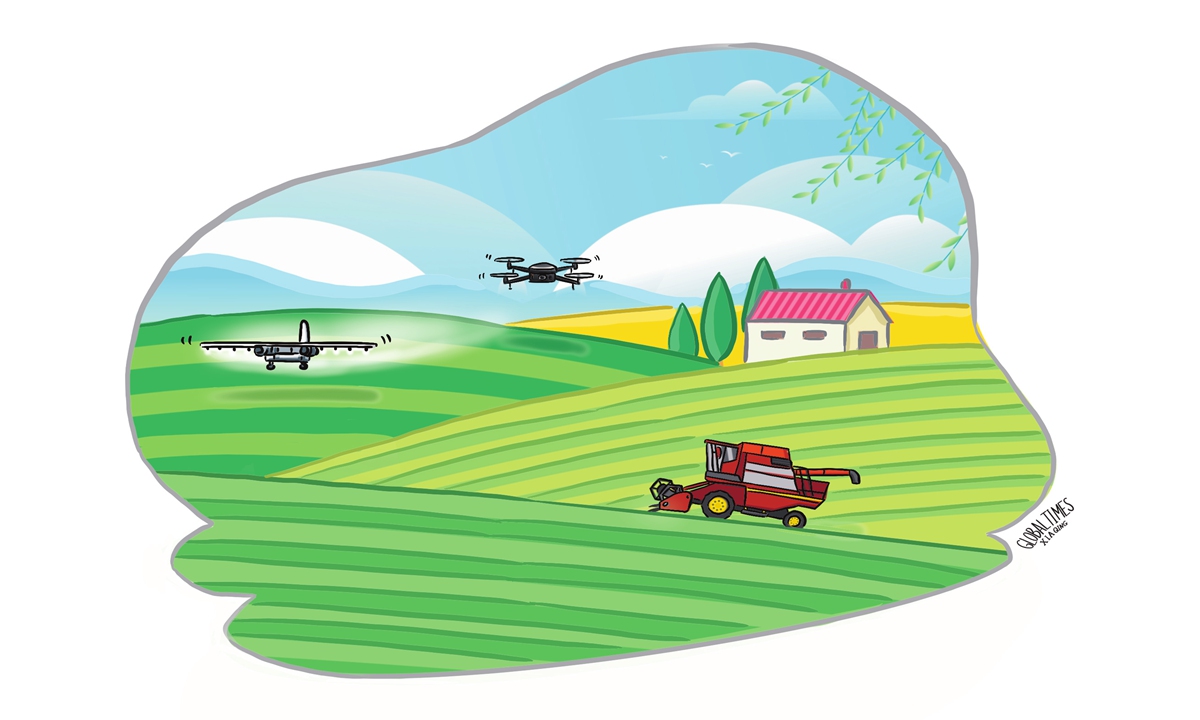
Illustration: Xia Qing/GT
The 7th China Grain Trading Conference, held from Saturday to Monday in Shenyang, Northeast China’s Liaoning Province, offered a practical look into China’s ongoing progress in integrating technological innovation into its grain industry. This event highlighted the nation’s unwavering efforts to modernize its agricultural sector through various means, including enhancing efficiency and productivity via innovation.
This year’s conference focused on grain circulation and aimed to create a platform for enterprises to innovate and collaborate across the entire grain industry chain. Emphasizing technological innovation, the event facilitated deeper integration between academic institutions and enterprises, fostering a synergy of research and application. This approach seeks to invigorate the grain industry through technology and talent, directing more resources toward its modernization and advancement, people.cn reported on Sunday.
This year’s event provided a vibrant showcase of new technologies, products, and business models in the agricultural sector. From “field robots” to “intelligent grain production lines,” the conference introduced numerous agricultural innovations, demonstrating the rapid development of China’s science and technology application in the farming sector and offering a forward-looking vision for the future of smart farming.
One example came from Liaoning. Several enterprises from Tieling presented advanced grain processing equipment that are helping to drive the industry toward greater intelligence, efficiency, and environmental sustainability, according to China National Radio.
The Liaoning Daily reported that the exhibition demonstrated the full value chain potential of a single grain of rice through several distinct product forms. For example, rice bran wax can be used in electrical insulator materials, methyl oleate in biopesticide formulations, and oryzanol as an antioxidant in food products. These examples underscore the growing role of biotechnology and green innovation in enhancing the added value of agricultural products.
In recent years, China’s scientific and technological innovation has played an increasingly important role in enhancing grain production, driving transformation across the entire supply chain. This encompasses advancements in seed varieties through biotechnology research and development, improved farming efficiency supported by digital monitoring technologies and upgraded equipment, and the application of smart storage systems.
Intelligent devices are revolutionizing the processing chain, technological innovations are modernizing operations, and the localization of high-end agricultural machinery is accelerating equipment upgrades.
China’s agricultural science and technology innovation has fully entered the world’s top ranks, with the contribution rate of agricultural technological progress in grain production exceeding 63 percent, the People’s Daily reported in February.
According to China Science and Technology Daily, Chinese authorities released 10 technological innovations in grain circulation in May. One of these innovations is the smart, green grain storage technology system. The system includes advanced technologies such as high-precision monitoring of grain storage, Internet of Things-based traceability, and risk warning systems, all aimed at enhancing the efficiency and sustainability of grain storage.
In 2024, China overcame challenges from natural disasters such as heat waves, drought, floods, and typhoons to achieve another successful grain harvest, with production surpassing 1.4 trillion jin (706.5 million tons) for the first time. However, grain production is just the beginning of a much longer industry chain. The 7th China Grain Trading Conference provided an opportunity to showcase advancements across the entire grain industry chain, including areas such as production, storage, and distribution. These technological strides are propelling the development of China’s comprehensive grain industry.
A report by Reuters in May, citing a US study, underscored a troubling trend: acute food insecurity and child malnutrition rose for a sixth consecutive year in 2024, affecting more than 295 million people across 53 countries and territories.
In the face of these growing challenges to global food security, China’s technological transformation of its grain industry not only strengthens the food security of approximately 1.4 billion people but also creates opportunities for international agricultural technology cooperation. According to a report on the National Food and Strategic Reserves Administration’s website, the 7th China Grain Trading Conference attracted businesses and industry associations from more than 30 countries, further expanding the potential for deepening grain trade cooperation.
While China has consistently made strides in the technological advancement of its grain industry, there is still room for further development. This indicates that sustained efforts are crucial. Through international collaboration, it is expected that these endeavors will positively contribute to global food security.
The author is a reporter with the Global Times. bizopinion@globaltimes.com.cn





